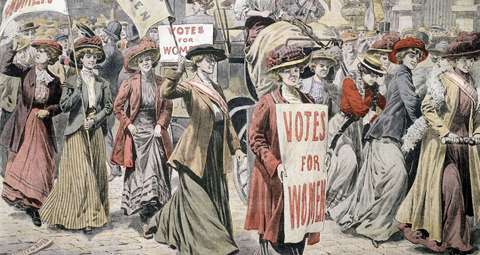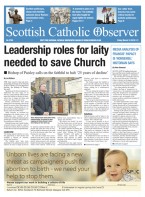March 16 | ![]() 0 COMMENTS
0 COMMENTS ![]() print
print

A wummin’s wummin: tale of a teacher who joined fight for equal rights
JOANNA MAGOUFAKIS speaks to the daughters of a Clydeside Catholic suffragist about her life and the fearless women she campaigned with - By JOANNA MAGOUFAKIS
Margaret McCann was a deeply spiritual woman, who met the man she was to marry on a visit to Lourdes. She was also a suffragist and feminist.
In the 100th anniversary year of some women winning the right to vote—women had to be over 30 and either own property or have been university educated in 1918—Mrs McCann’s daughters tell the tale of their mother, a Scottish Roman Catholic who joined the radical fight for equal rights.
Margaret McCann was born on January 27, 1909. What later drew her to the women’s movement is unclear, but she would enrol as a young woman at the University of Glasgow’s Queen Margaret College, which was led by ardent feminists.
“She always spoke admiringly of those women,” her daughter, Dr Catherine Mason, said. “They introduced her to the Women’s Freedom League (WFL). This gave her not only practical experience but also a summer break from the poverty that surrounded her at home.”
Dr Mason and her sister, Bernadette Cahill, aim to raise awareness of the role their mother and her Catholic Faith played in the suffragettes’ struggle.
Ms Cahill is an independent scholar on women’s emancipation who has worked for women’s rights in Britain, Ireland and the United States. She is also a journalist and historian, and has written extensively about issues affecting women. She is now giving talks about her mother and the suffragettes who came before her.
Dr Mason explained how difficult life was for her mother—and women in general—because they were not equal before the law.
“Men could control a woman. The domestic environment was often controlling and abusive,” she said. “It was only in 1964 that, if a man died, his wife had a ‘claim’ on his estate. She did not have a right to it, but a claim. Before that women inherited nothing; everything went to the eldest son.”
Mrs McCann was pressured to give up her job as a teacher when she got married after the war, simply because she was a woman, but she continued teaching regardless, even though she was soon a mother of four children.
“She was badly treated by the schools so she was very conscious of the discrimination against women,” Ms Cahill said.
Her mother, she said, spoke admiringly of the campaigning suffragettes who introduced her to the WFL. The WFL, which was a militant but non-violent group, used peaceful means of withholding tax and public protest to assert their right to petition the king and parliament.
Mrs McCann was inspired by the suffragists who came before her. She told her daughters about one of the most memorable protests that took place in 1908 at the Palace of Westminster.
“A couple of the group’s members went into the House of Commons where there was what I call a ‘leper plaque’ behind a grille where women were allowed to listen to debates,” Ms Cahill said. “They chained themselves to the grille and what happened was that authorities came and cut the grille out.”
It took until 1917 to put the grille back up again.
The most poignant and most important protest the WFL took part in happened in 1909 when members of the group picketed the Commons for 15 weeks in a row.
“They were trying to hand in a petition to Prime Minister Herbert Asquith who was one of the strongest opponents of votes for women,” Ms Cahill said.
The protest had a powerful influence on the United States where two women, Alice Paul and Lucy Burns, for the first time in American history, had started picketing the President outside the White House—they stood with their banners in silence, waiting to hand in their petition.
“This was the first civil rights struggle in the United States,” Ms Cahill said. “Most people say that the first struggle [for civil rights for black Americans] was in the 50s or 60s but it goes back way before that—and it was the women,” she said.
Paul and Burns, both American-born, came to Britain and joined the suffragettes in London. They became active in Scotland and moved to Dundee, where they soon ended up under arrest.
“They were the first women to be imprisoned in Scotland for protesting,” Ms Cahill said.
This connection with Scotland and Britain was crucial for women’s rights in the United States.
“These women went back to the United States and from 1913 they began the last campaign in the states to win the vote for women,” Ms Cahill said. “They are the ones who were instrumental in enabling the passage of the 19th Amendment [which gave women the right to vote] in 1920.”
Dr Mason said that not all suffragettes were as committed to non-violence as her mother.
Lilian Lenton, from Leicester, was only 21 in 1912 when she joined the militant and violent group called the Women’s Social and Political Union (WSPU). She went on to win the French Red Cross medal for her work as an orderly in Serbia during the First World War, leading to her being addressed as ‘madam.’ She later became an active speaker on behalf of the peaceful WFL. It was there that Mrs McCann met her. She would later say she was proud to have worked alongside Madam Lenton during her own years at university.
The young Lenton was jailed for smashing windows in protest at women’s inequality. However, that only served to further criminalise her—in 1913 she was involved in fire-raising attacks, which again landed her in jail, where she was subjected to force feeding with horrific results.
“Lenton went on her hunger strike. She was force-fed with a tube that was stuck down her throat or nose,” Dr Mason said. “The women were fighting it but were held down. It was torture. This tube went into her lung and she ended up with pleurisy. They were trying to cover this up.”
It later emerged that the food had been forced into her lungs, causing her illness.
Lenton was released from jail, received treatment and recovered. In the meanwhile, under the so-called Cat and Mouse Act of 1913, hunger-striking women [the mice] who had been released from prison due to ill health, were later recalled to prison by the authorities [the cats] once their health had recovered, where the process would begin again. Despite the suffragettes’ efforts, many politicians in the UK seemed set in their misogynistic beliefs. Ahead of the vote on increasing suffrage, the Liberal politician Sir Charles Hobhouse warned that ‘the 12 million women in the country would double the present electorate and for the first time in the history of any country in any circumstances women would be given the balance of power.’
In 1918, approximately 50 per cent of the women in the UK got the right to vote. Madam Lenton belonged to the 50 per cent still disenfranchised. The battle continued. It would be 1928 before the franchise was extended to all women over 21.
The WFL was active in many parts of Scotland, especially Rothesay on the Isle of Bute because the island attracted about 70,000 visitors during the summer period. The women who made up its membership had a wit that matched their enthusiasm, as Dr Mason illustrated with one story about a public suffragette event in Glasgow.
“Once they began talking, one wee Glasgow man with a flatcap started shouting ‘A wummin’s place is in the home!’ Now, Madam Lenton was ready for anybody and knew the wee man in the flatcap did not stand a chance. So she replied: ‘There are two million surplus women! How on earth are these two million women to have a home, if the only home is with a man, and there are two million men short!”
Mrs McCann told her daughter that such incidents would occur all the time, but they were prepared to deal with them. Her strong Faith also helped her. “She was very intensely spiritual,” Ms Cahill said. “She prayed the Rosary, went to Mass, did Novenas all the time and she met my dad in Lourdes after the war when there on a pilgrimage.”
Dr Mason said her mother was held in high regard by those priests who knew her. “She was very respected as a woman of high character and high principles. But she said she did not agree with the Church on everything, and was willing to fight her corner.”
Dr Mason has a clear view on how her mother, who died in 1986, would have viewed the continuing struggle for equal rights and the part the Church and her Faith has to play in it. She smiled as she said: “She would be in tune with Pope Francis. She and Pope Francis would get on like a house on fire.
“Life has taken a lot of time to get to where you are, but we have a long way to go—for equality of men as well.
“It is a total contradiction to suggest that there should be ‘priorities’ for equality. If there is equality it is equality and that is what the women’s movement stood for.”











